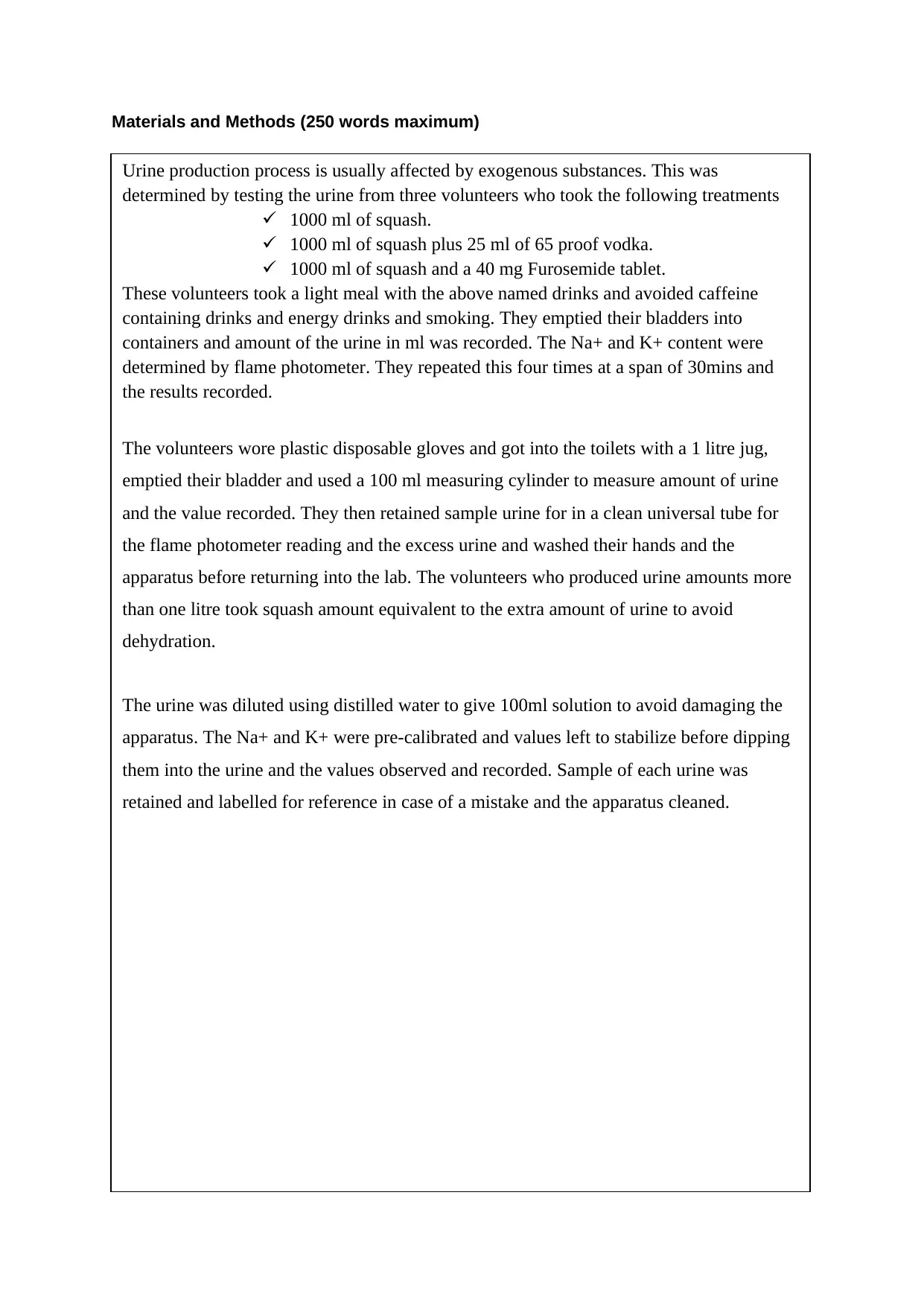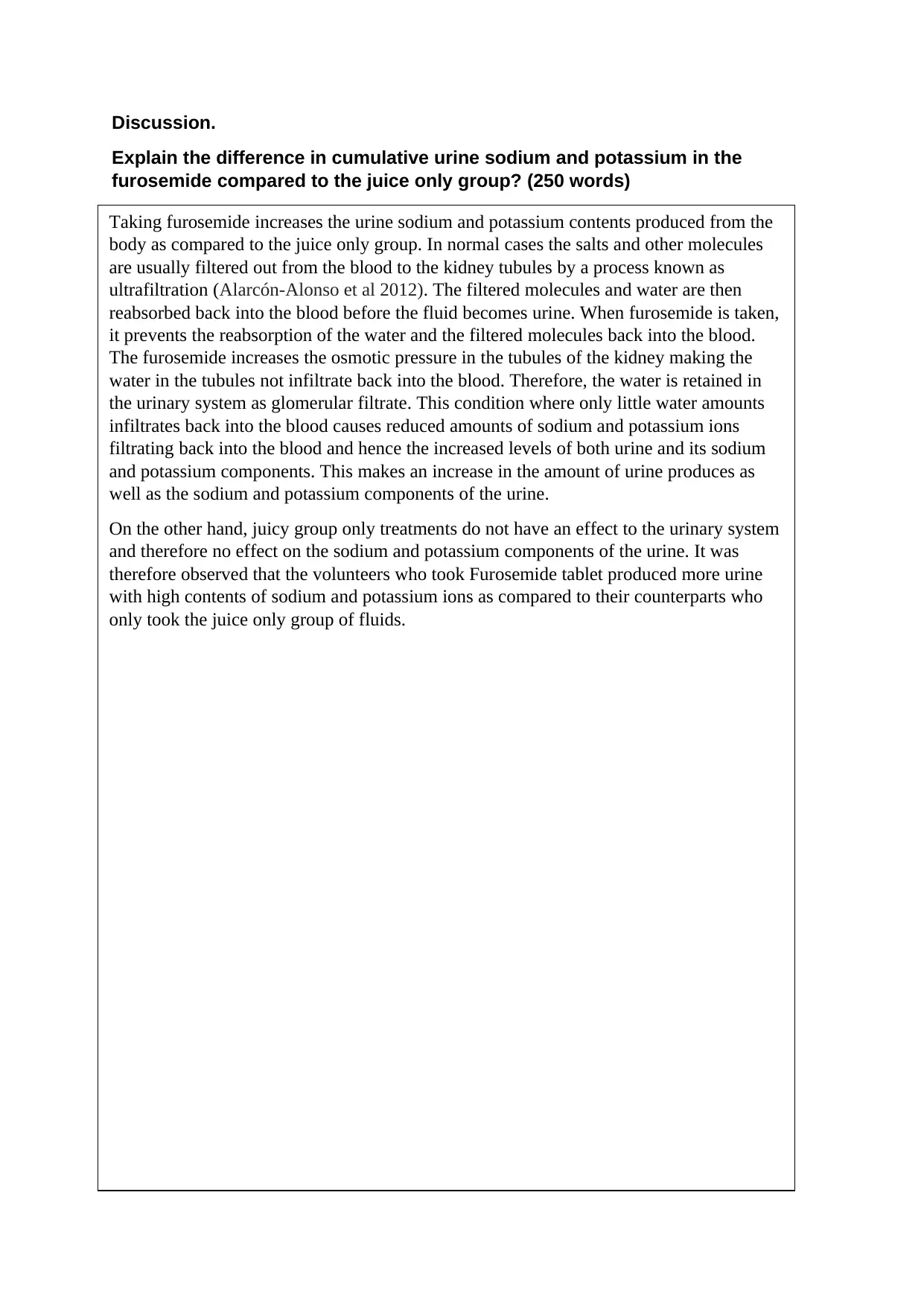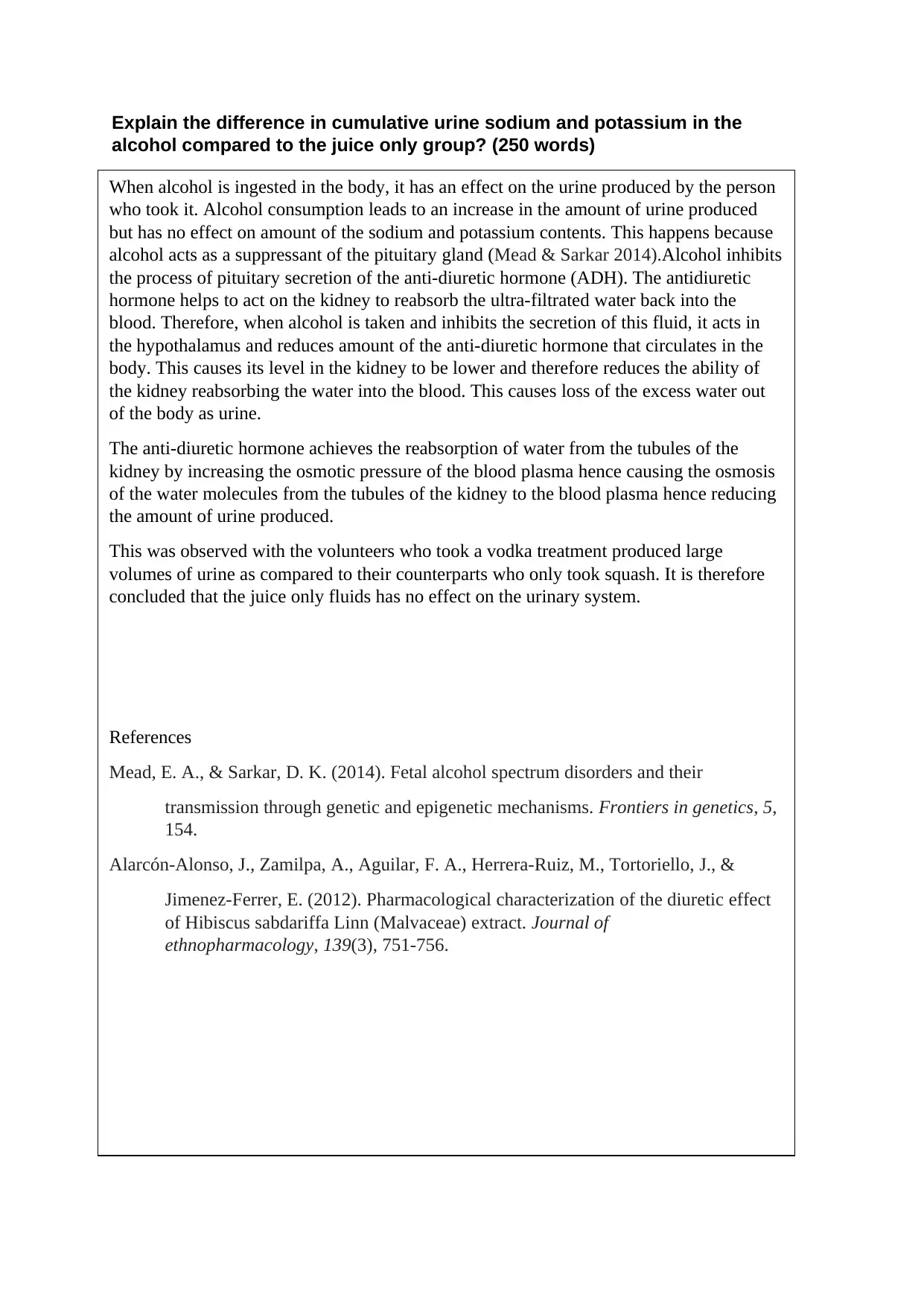Renal Function Lab Write-up Template
VerifiedAdded on 2023/03/17
|4
|962
|85
AI Summary
This lab write-up template discusses the process of testing urine production and the effects of different substances on sodium and potassium levels. It includes materials and methods, discussion, and references.
Contribute Materials
Your contribution can guide someone’s learning journey. Share your
documents today.

Intermediate Human Physiology (BY266)
Renal function lab class write-up template
Student No:
Renal function lab class write-up template
Student No:
Secure Best Marks with AI Grader
Need help grading? Try our AI Grader for instant feedback on your assignments.

Materials and Methods (250 words maximum)
Urine production process is usually affected by exogenous substances. This was
determined by testing the urine from three volunteers who took the following treatments
1000 ml of squash.
1000 ml of squash plus 25 ml of 65 proof vodka.
1000 ml of squash and a 40 mg Furosemide tablet.
These volunteers took a light meal with the above named drinks and avoided caffeine
containing drinks and energy drinks and smoking. They emptied their bladders into
containers and amount of the urine in ml was recorded. The Na+ and K+ content were
determined by flame photometer. They repeated this four times at a span of 30mins and
the results recorded.
The volunteers wore plastic disposable gloves and got into the toilets with a 1 litre jug,
emptied their bladder and used a 100 ml measuring cylinder to measure amount of urine
and the value recorded. They then retained sample urine for in a clean universal tube for
the flame photometer reading and the excess urine and washed their hands and the
apparatus before returning into the lab. The volunteers who produced urine amounts more
than one litre took squash amount equivalent to the extra amount of urine to avoid
dehydration.
The urine was diluted using distilled water to give 100ml solution to avoid damaging the
apparatus. The Na+ and K+ were pre-calibrated and values left to stabilize before dipping
them into the urine and the values observed and recorded. Sample of each urine was
retained and labelled for reference in case of a mistake and the apparatus cleaned.
Urine production process is usually affected by exogenous substances. This was
determined by testing the urine from three volunteers who took the following treatments
1000 ml of squash.
1000 ml of squash plus 25 ml of 65 proof vodka.
1000 ml of squash and a 40 mg Furosemide tablet.
These volunteers took a light meal with the above named drinks and avoided caffeine
containing drinks and energy drinks and smoking. They emptied their bladders into
containers and amount of the urine in ml was recorded. The Na+ and K+ content were
determined by flame photometer. They repeated this four times at a span of 30mins and
the results recorded.
The volunteers wore plastic disposable gloves and got into the toilets with a 1 litre jug,
emptied their bladder and used a 100 ml measuring cylinder to measure amount of urine
and the value recorded. They then retained sample urine for in a clean universal tube for
the flame photometer reading and the excess urine and washed their hands and the
apparatus before returning into the lab. The volunteers who produced urine amounts more
than one litre took squash amount equivalent to the extra amount of urine to avoid
dehydration.
The urine was diluted using distilled water to give 100ml solution to avoid damaging the
apparatus. The Na+ and K+ were pre-calibrated and values left to stabilize before dipping
them into the urine and the values observed and recorded. Sample of each urine was
retained and labelled for reference in case of a mistake and the apparatus cleaned.

Discussion.
Explain the difference in cumulative urine sodium and potassium in the
furosemide compared to the juice only group? (250 words)
Taking furosemide increases the urine sodium and potassium contents produced from the
body as compared to the juice only group. In normal cases the salts and other molecules
are usually filtered out from the blood to the kidney tubules by a process known as
ultrafiltration (Alarcón-Alonso et al 2012). The filtered molecules and water are then
reabsorbed back into the blood before the fluid becomes urine. When furosemide is taken,
it prevents the reabsorption of the water and the filtered molecules back into the blood.
The furosemide increases the osmotic pressure in the tubules of the kidney making the
water in the tubules not infiltrate back into the blood. Therefore, the water is retained in
the urinary system as glomerular filtrate. This condition where only little water amounts
infiltrates back into the blood causes reduced amounts of sodium and potassium ions
filtrating back into the blood and hence the increased levels of both urine and its sodium
and potassium components. This makes an increase in the amount of urine produces as
well as the sodium and potassium components of the urine.
On the other hand, juicy group only treatments do not have an effect to the urinary system
and therefore no effect on the sodium and potassium components of the urine. It was
therefore observed that the volunteers who took Furosemide tablet produced more urine
with high contents of sodium and potassium ions as compared to their counterparts who
only took the juice only group of fluids.
Explain the difference in cumulative urine sodium and potassium in the
furosemide compared to the juice only group? (250 words)
Taking furosemide increases the urine sodium and potassium contents produced from the
body as compared to the juice only group. In normal cases the salts and other molecules
are usually filtered out from the blood to the kidney tubules by a process known as
ultrafiltration (Alarcón-Alonso et al 2012). The filtered molecules and water are then
reabsorbed back into the blood before the fluid becomes urine. When furosemide is taken,
it prevents the reabsorption of the water and the filtered molecules back into the blood.
The furosemide increases the osmotic pressure in the tubules of the kidney making the
water in the tubules not infiltrate back into the blood. Therefore, the water is retained in
the urinary system as glomerular filtrate. This condition where only little water amounts
infiltrates back into the blood causes reduced amounts of sodium and potassium ions
filtrating back into the blood and hence the increased levels of both urine and its sodium
and potassium components. This makes an increase in the amount of urine produces as
well as the sodium and potassium components of the urine.
On the other hand, juicy group only treatments do not have an effect to the urinary system
and therefore no effect on the sodium and potassium components of the urine. It was
therefore observed that the volunteers who took Furosemide tablet produced more urine
with high contents of sodium and potassium ions as compared to their counterparts who
only took the juice only group of fluids.

Explain the difference in cumulative urine sodium and potassium in the
alcohol compared to the juice only group? (250 words)
When alcohol is ingested in the body, it has an effect on the urine produced by the person
who took it. Alcohol consumption leads to an increase in the amount of urine produced
but has no effect on amount of the sodium and potassium contents. This happens because
alcohol acts as a suppressant of the pituitary gland (Mead & Sarkar 2014).Alcohol inhibits
the process of pituitary secretion of the anti-diuretic hormone (ADH). The antidiuretic
hormone helps to act on the kidney to reabsorb the ultra-filtrated water back into the
blood. Therefore, when alcohol is taken and inhibits the secretion of this fluid, it acts in
the hypothalamus and reduces amount of the anti-diuretic hormone that circulates in the
body. This causes its level in the kidney to be lower and therefore reduces the ability of
the kidney reabsorbing the water into the blood. This causes loss of the excess water out
of the body as urine.
The anti-diuretic hormone achieves the reabsorption of water from the tubules of the
kidney by increasing the osmotic pressure of the blood plasma hence causing the osmosis
of the water molecules from the tubules of the kidney to the blood plasma hence reducing
the amount of urine produced.
This was observed with the volunteers who took a vodka treatment produced large
volumes of urine as compared to their counterparts who only took squash. It is therefore
concluded that the juice only fluids has no effect on the urinary system.
References
Mead, E. A., & Sarkar, D. K. (2014). Fetal alcohol spectrum disorders and their
transmission through genetic and epigenetic mechanisms. Frontiers in genetics, 5,
154.
Alarcón-Alonso, J., Zamilpa, A., Aguilar, F. A., Herrera-Ruiz, M., Tortoriello, J., &
Jimenez-Ferrer, E. (2012). Pharmacological characterization of the diuretic effect
of Hibiscus sabdariffa Linn (Malvaceae) extract. Journal of
ethnopharmacology, 139(3), 751-756.
alcohol compared to the juice only group? (250 words)
When alcohol is ingested in the body, it has an effect on the urine produced by the person
who took it. Alcohol consumption leads to an increase in the amount of urine produced
but has no effect on amount of the sodium and potassium contents. This happens because
alcohol acts as a suppressant of the pituitary gland (Mead & Sarkar 2014).Alcohol inhibits
the process of pituitary secretion of the anti-diuretic hormone (ADH). The antidiuretic
hormone helps to act on the kidney to reabsorb the ultra-filtrated water back into the
blood. Therefore, when alcohol is taken and inhibits the secretion of this fluid, it acts in
the hypothalamus and reduces amount of the anti-diuretic hormone that circulates in the
body. This causes its level in the kidney to be lower and therefore reduces the ability of
the kidney reabsorbing the water into the blood. This causes loss of the excess water out
of the body as urine.
The anti-diuretic hormone achieves the reabsorption of water from the tubules of the
kidney by increasing the osmotic pressure of the blood plasma hence causing the osmosis
of the water molecules from the tubules of the kidney to the blood plasma hence reducing
the amount of urine produced.
This was observed with the volunteers who took a vodka treatment produced large
volumes of urine as compared to their counterparts who only took squash. It is therefore
concluded that the juice only fluids has no effect on the urinary system.
References
Mead, E. A., & Sarkar, D. K. (2014). Fetal alcohol spectrum disorders and their
transmission through genetic and epigenetic mechanisms. Frontiers in genetics, 5,
154.
Alarcón-Alonso, J., Zamilpa, A., Aguilar, F. A., Herrera-Ruiz, M., Tortoriello, J., &
Jimenez-Ferrer, E. (2012). Pharmacological characterization of the diuretic effect
of Hibiscus sabdariffa Linn (Malvaceae) extract. Journal of
ethnopharmacology, 139(3), 751-756.
1 out of 4
![[object Object]](/_next/static/media/star-bottom.7253800d.svg)
